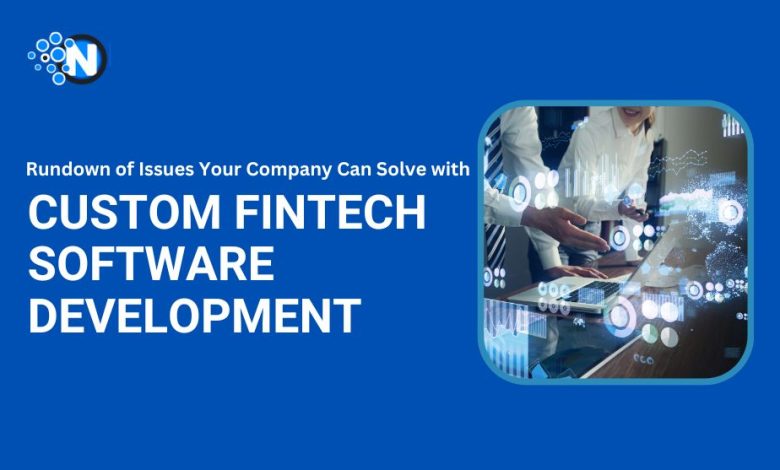Issues Your Company Can Solve with Custom FinTech Software Development

FinTech solutions come in various shapes and sizes, from sleek payment applications with NFC capabilities to online lending platforms, blockchain-based digital wallets, and fraud detection algorithms.
The global FinTech market, which is on track to top $556 billion by 2030, is currently dominated by commercially available tools and platforms.
On the consumer side, these include payment solutions like PayPal and Stripe, personal wealth management and trading apps like Betterment and Robinhood, and insurance technology (InsurTech) products, such as Oscar Health and Lemonade.
In the enterprise technology segment, there is a plethora of platforms that allow banks, insurance companies, and other types of financial services organizations to manage their processes more effectively. Among such FinTech solutions are SAP Financial Services, Findur, and Finastra.
If your company is thinking of integrating a FinTech tool into your IT infrastructure, you won’t be short of choices.
In some cases, however, financial software development company would make more sense than procuring commercially available tools.
In this article, we will discuss the common approaches to FinTech implementation and pinpoint issues that bespoke FinTech solutions help address.
Top 3 Approaches to FinTech Software Implementation
When FinTech companies put out a novel software product, they aim to address specific problems financial services companies face, providing a turnkey solution that requires little to no customization and can generate ROI from day one.
Let’s take Finastra, for example.
The company operates a comprehensive suite of cloud-based FinTech solutions for cash management, commercial and consumer lending, and digital banking. The company is striving to open its ecosystem to third-party developers, allowing other FinTech vendors to integrate their products with Finastra’s FusionFabric.cloud over APIs and running a marketplace where compatible apps are featured.
Regardless of its numerous advantages, however, the platform can be challenging to scale and interface with external and internal software solutions, has a steep learning curve, and may entail significant customization and maintenance costs.
That’s why procuring software (SaaS) and platform-as-a-service (PaaS) solutions is just one approach to FinTech software implementation.

The complete list of options looks as follows:
- Utilizing commercially available SaaS and PaaS FinTech products, which may require heavy customization and managed services.
- Building FinTech solutions using no-code or low-code development tools, such as Appy Pie for consumer banking apps and Nintex for enterprise-grade applications. Alternatively, you could consider a white-label FinTech platform like SDK.finance, customizing the tool to meet your business needs and corporate design guidelines.
- Developing FinTech products from the ground up, either employing your in-house IT department or through a partnership with a custom software engineering. To speed up the development process, your software engineers will use a combination of frameworks, libraries, and SDKs, such as Spring Boot, Django, React, TensorFlow, and cloud services.
Each of these approaches has distinctive benefits and limitations:
- SaaS and PaaS-based FinTech products take less time to implement and may contain industry-specific modules and services, so your company won’t have to reinvent the wheel. However, adopting commercially available FinTech solutions requires significant upfront and ongoing expenses and may result in a vendor lock-in, i.e., a scenario where your company becomes over-reliant on a particular vendor in terms of software updates, cloud infrastructure, and pricing. Additionally, some commercially available tools, such as SAP, may be tricky to customize.
- White-label solutions often lack essential features, modules, and integrations, and you’ll still have to enlist the help of skilled software developers to tweak the software in line with your requirements. No-code/low-code platforms’ key advantage revolves around visual development capabilities. Using drag-and-drop user interface (UI) builders, you can create FinTech apps with little to no coding skills, which is an advantage for companies lacking software engineering talent. Codeless solutions, however, are best suited for applications used internally. They may not be the most cost-effective option because, in addition to licensing fees, these platforms typically charge businesses based on the number of server calls made by applications.
- By going the custom route, you’ll be able to create software that fully addresses the unique needs of your organization. Bespoke FinTech solutions work in sync with your existing IT infrastructure, including legacy apps, allow for effortless customization and enhancement, and, if architected properly, can scale flexibly along with your business. From a less favorable perspective, the duration of a custom FinTech software development project may range from 3 months for a basic application to several years for large, complex initiatives involving heavy customizations and integration with multiple systems. The median price tag for a bespoke FinTech system can thus fluctuate between $100,000 and $200,000 (and counting).

What Issues Could Your Company Tackle by Choosing Custom FinTech Software Development?
Now that we’ve walked you through some of the FinTech implementation options your company could pursue, let’s enumerate the obstacles you could overcome by tapping into custom FinTech software development:
- Bespoke FinTech solutions are designed to address your unique business needs, from monitoring payment transactions in real time to building custom reports with the help of self-service business intelligence (BI) dashboards.
- Custom FinTech products can be enhanced with leading-edge features, such as built-in support for generative artificial intelligence (Gen AI) or integration with cyber-physical systems. Typically missing in commercially available FinTech tools, such functionality can give your business a strong competitive advantage.
- Custom-built FinTech systems are designed to seamlessly interface with your existing software and aggregate the operational data they keep. This, in turn, allows you to achieve 360-degree visibility into your operations.
- Provided you create a blueprint of your software architecture early on and plan for growth, your bespoke systems will be able to add storage and computing resources on demand, supporting your organization’s growth and innovation.
- Bespoke FinTech products grant companies complete control over their data and technology systems, minimizing cybersecurity risks.
- While requiring substantial upfront investments, custom software is more cost-effective in the long run as you won’t have to pay ongoing licensing fees or customize your applications extensively.
- Bespoke FinTech software has your brand written all over it, providing a consistent experience that might not be achievable with generic SaaS or white-label products.
- With custom software, you’ll avoid vendor lock-in, avoiding situations where increasing FinTech vendor fees may jeopardize the profitability of your business.
- If your business model focuses on delivering innovative financial services or targeting niche markets, no off-the-shelf solution will ever meet these needs while ensuring regulatory compliance.
Conclusion
At the end of the day, there is no right or wrong approach to FinTech implementation.
The decision to purchase a readily available platform or take the custom path depends on your specific business goals, innovation strategy, and growth objectives.
However, in many cases, it is custom software development that helps differentiate your business, supercharge customer experience, and give you a competitive edge, which is key to survival in the digital era.




